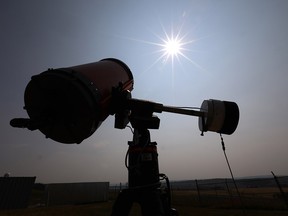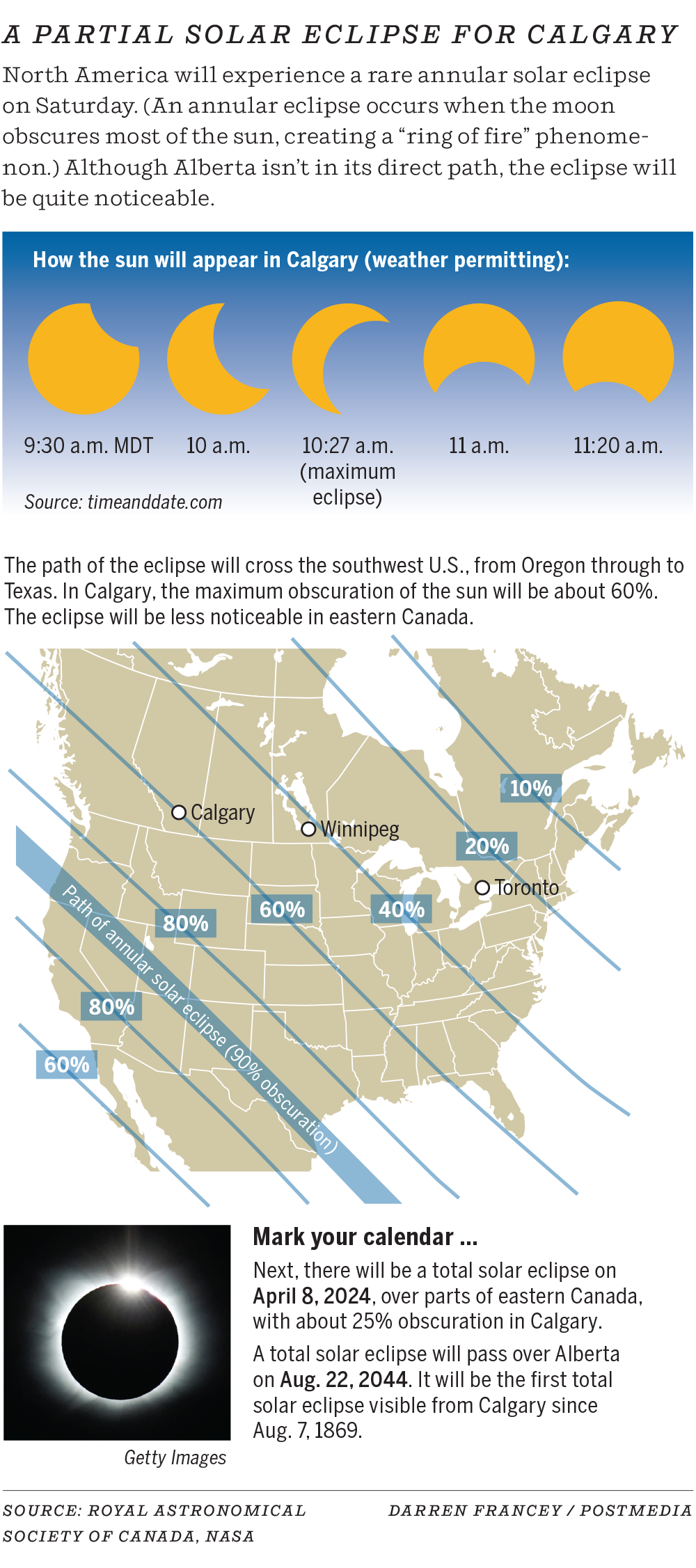Annular 'ring of fire' solar eclipse will dim daytime skies this Saturday
While the eclipse won't pass directly over Calgary, you should still be able to witness a partial blocking of the sun at around 10:30 a.m.

Article content
Astronomy enthusiasts in Calgary will turn their eyes to the sky on Saturday, as an annular solar eclipse sweeps across parts of North America.
An annular solar eclipse occurs when the moon passes directly between the sun and the Earth, but due to its elliptical orbit is too far from the Earth to block out the sun entirely — as would be the case during a total eclipse.
The result is a shining “ring of fire” that makes the partially blocked sun appear as a glowing circle in the sky.
“When (the moon) passes in front of the sun, instead of blocking the sun completely there’s a crescent annulus of the sun that creeps around the outside of the moon,” said Dr. Phil Langill, the director of the Rothney Astrophysics Observatory and a professor in the University of Calgary’s physics and astronomy department.
Saturday’s eclipse is set to begin shortly after 9 a.m. and be over around noon, with peak viewing around 10:30 a.m.
While the annular eclipse’s diagonal path won’t pass over Calgary, Langill said local observers should still be able to witness a partial blocking of the sun — particularly between 10 and 11 a.m.
“They happen in slow-mo, so you don’t have to rush outside or else you’d miss it,” he said, adding Calgarians should see about 60 per cent of the sun obscured.
The best views will be in the southwestern U.S.
Where to watch the eclipse in Calgary
Calgarians can view the eclipse at two public events on Saturday.
The first is a ticketed event at Telus Spark Science Centre, in partnership with the Calgary branch of the Royal Astronomical Society of Canada (RASC). The event, which runs from 8:30 a.m. to noon, will broadcast NASA’s live feed of the annular eclipse from the science centre’s infinity dome theatre.
Outside, telescopes with solar-protective filters will be set up on the south side of the building for viewers to check out the partial eclipse without risking damage to their eyes.
Steve Donaldson, the first vice-president of RASC Calgary Centre, said a few thousand people are expected.
“It’s not every day a particular spot on the Earth gets a solar eclipse,” he said.
“It’s a very majestic thing to see.”
Dr. Stephen Jeans, an earth and sciences instructor at Mount Royal University and Ambrose University, will also host a free eclipse viewing party at the Ambrose University campus. Participants will be able to use specially designed solar eclipse lenses and telescopes with safe solar filters to view the celestial display.
Jeans called seeing a solar eclipse a “bucket list” activity for many people, adding if someone were to stay in the same place their whole life, the likelihood of a solar eclipse passing over them is only once in every 383 years.
“It’s not really that frequent that we get to see such a wonderful celestial event in the sky,” Jeans said.
He said the Ambrose viewing party will also provide other educational opportunities as he, his students and astronomers from RASC Calgary Centre will be available to answer questions about eclipses, sun spots and other space-related phenomena.
Jeans’ Ambrose University event will run from 9:30 to 11:45 a.m. in the Mahood Commons.

Total eclipse coming next April
For astronomy lovers, this weekend’s annular eclipse will be a warm-up for a more exciting event next spring. A total solar eclipse is slated to darken the daytime skies on April 8, 2024, as it traverses swaths of Mexico, the United States and Canada.
While that eclipse also won’t pass over Calgary, according to NASA, it should be on full display in Montreal, near Toronto, and in parts of Eastern Canada.
“It’s really quite spectacular,” Donaldson said. “All the animals think it’s nighttime and start going to bed. You see the shadow of the moon approaching and when it finally blocks the sun, you get darkness. You look up and just see this black hole in the sky with this ghostly whiteish corona.
“And then, after a few minutes, it’s all over and the sun reappears.”

Langill said the coolest thing about solar eclipses is they highlight the movement of celestial bodies that otherwise appear to be stationary when viewed through a telescope.
“We live on a big spinning ball, so there’s a whole bunch of motion in the universe happening right in front of your eyes. An eclipse gives you the chance to really perceive and notice it,” he said. “If it wasn’t for this orbital motion, we’d never get this event.
“So for these three hours (on Saturday), people should remember that what’s really happening is the moon is whipping around the Earth, and it just happens to be using the sun as a marker.”







Postmedia is committed to maintaining a lively but civil forum for discussion. Please keep comments relevant and respectful. Comments may take up to an hour to appear on the site. You will receive an email if there is a reply to your comment, an update to a thread you follow or if a user you follow comments. Visit our Community Guidelines for more information.